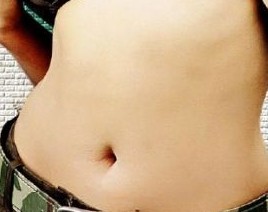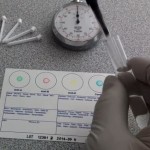Pain around belly button may occur due to a variety of causes. Some of the common causes and associated symptoms and treatments are discussed below.
Causes of pain around belly button
Pain around belly button may be caused due to the following conditions:

- Decreased moisture content in the environment, especially during winters, and the subsequent use of warm clothing can cause the area around the belly button to become dry. This can result in itchiness and pain around belly button.
- Along with pain around belly button, overeating can also cause acidity, stomach pain, and gas.
- Buildup of dirt and debris in the belly button can irritate the skin in and around the navel, thereby increasing the risk to infections, itchiness, redness, inflammation, and pain around belly button.
- Minor cuts, wounds, injuries in the navel area can also cause pain and set the stage for future infections.
- Wearing tight pants can constrict blood circulation to the belly area, leading to local pain, itchiness, and discomfort.
- Infection of the navel area by a yeast called Candidiasis albicans can also cause pain around belly button. Patients may experience itching, redness, and a smelly, cottage cheese or yogurt-like discharge from the area. Candidiasis is treated with topical and oral antifungals.
- Stomach flu is a viral infection marked by inflammation of the intestinal and stomach linings. It can cause pain around belly button as well as diarrhea, indigestion, abdominal cramping, and vomiting immediately after eating.
- People pierce the belly button and adorn them with jewelry. Allergy of the skin to the metal, unprofessional piercing work, or bad personal hygiene can lead to infection of the piercing. An infected belly button piercing can result in pain around belly button, itchiness, redness, swelling, pus deposition, and smelly discharge. It is treated with antibiotics.
- Located in the abdomen, the gallbladder is an organ that stores bile and aids digestion of fat. Gallbladder disease can occur due to infection, inflammation, blockages, obstructions, or stones in the organ. It can cause radiating pain in and around the belly button, severe abdominal pain during urination, fever, nausea, chills, chest pain, stomach fullness, vomiting, and heartburn. It is treated via lifestyle and diet changes and surgery.
- Presence of skin disease like hives, eczema, etc. in the abdominal area can cause itchiness, redness, and pain around belly button. Use of harsh soaps or body lotions can cause contact dermatitis and similar symptoms. Contact a dermatologist for treatment.
- Appearance of a characteristic bulge in the belly button area is known as umbilical hernia. Most common in children and infants, it occurs when a part of the intestines protrudes out through a weak spot in the abdominal tissues near the navel. Affected children may suffer from chronic, sharp, or mild pain around belly button, which may intensify when coughing or crying.
- Strenuous and heavy workouts can exert increased pressure on the muscles of the abdomen and trigger a temporary case of pain around belly button.
- Located at the back of the stomach, the pancreas secretes enzymes that promote digestion. Inflammation of this organ causes pancreatitis which is marked by radiating pain in and around belly button that intensifies post meals, nausea, impaired digestion, and vomiting. Treatment includes lifestyle changes, medications, and surgery, if needed.
- Urinary tract infections or UTIs are another cause of pain around belly button. Additional symptoms include frequent urination, itchiness, painful urination, and burning sensations during urination, etc. It is treated with antibiotics.
- Cystitis is a type of UTI marked by inflammation of the bladder. In addition to above symptoms patients may also suffer from bloody urine, increased pressure in lower abdomen, and mild fever, etc. Untreated cases of cystitis can trigger a case of kidney infection, which is an emergency medical condition.
- Appendicitis refers to swelling, inflammation, and enlargement of the appendix. Affected individuals may suffer from mild to severe pain which initially begins on the right side of the abdomen, spreads to in and around the belly button, and slowly moves downwards. The pain is often intensified after a meal. Other symptoms include vomiting, constipation, loss of appetite, nausea, low fever, diarrhea, abdominal swelling, and gas. Severe pain associated with appendicitis is often a medical emergency requiring surgical treatment.
- Stretching and distention of the abdomen during pregnancy as well as additional pressure exerted by the growing fetus on the body can result in pain around belly button. The pain begins at the start of the third trimester, keeps intensifying, and only abates after childbirth.
- Infection of the gastrointestinal tract by H. pylori bacteria, alcoholism, smoking, and improper diet can cause small tissue damage in the tract resulting in formation of ulcers. The ulcers can then cause pain around belly button, nausea, vomiting, loss of weight, loss of appetite, burping, bloating, and bloody stools. It is treated with medications and lifestyle changes.
- Other causes of pain around belly button include Crohn’s disease, food poisoning, internal bleeding, urachal cyst, older abdominal surgeries, patent urachus, ovarian cysts, stress, and chronic or acute constipation and/or diarrhea.


